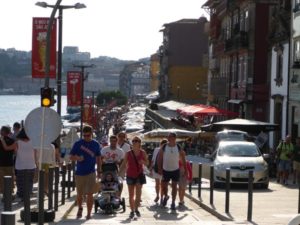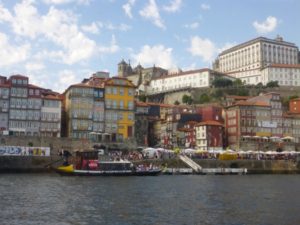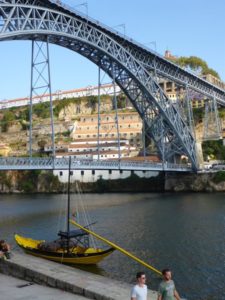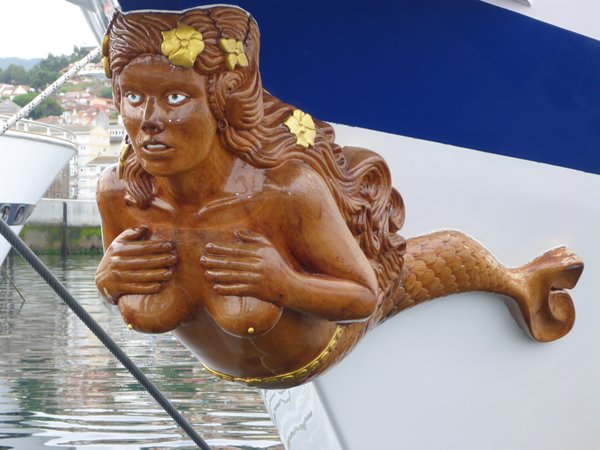42:07.47N 008:50.55W
Bayona; Booms, Bangs, Bands, Bells and Bosoms
(The photo will explain, they weren’t mine, mores the pity).
14th August. It would be nice to think the booms of guns, bangs of rockets, church bells and bands playing were for my birthday, but I wouldn’t be so bold, there was yet another festival under way and everybody was having a good time. We booked into the marina for two nights of extreme comfort and moderate expense. The four times rule applies here to the cost of mooring, sailing tuition for youngsters and clothes washing, so we anchored for the third night and I trod the washing in our 5 gallon white bucket.
As soon as we arrived we booked a table for the evening birthday meal and then wandered around the old town. Rob bought ice creams from a sweet young man in a gelataria who, when I mentioned it was my birthday, let me have my raspberry and caramel ice cream as a present.
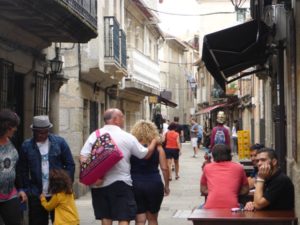
We had a beer in one of the stone-walled streets of the old town before smartening up our clothes for the Yacht Club Restaurant, where formal dress and ties used to be the order of the day. Nowadays I think they are just glad of the business regardless of the attire it arrives in. The clubhouse has wood panelled walls and big sliding windows onto the shady veranda around two sides. Gold names on the wall plaques hark back to times when the club members raced against Lymington Yacht Club and Clubs in America.
I wondered why that tradition seems to have ended, maybe for financial reasons. Well the sea urchin croquettes were novel, the grilled squid really tender and the lobster paella we shared was delicious. A slab of chocolate cake filled us up and the bill was very reasonable, especially as we discovered later they had forgotten to charge us for the two massive G & Ts we had to start with.
The next morning we walked around the outer perimeter of the Parador Conde do Gondomar hill fort which stands above the marina and protects the approach to Bayona. Fine views all around from the land out to sea and back again, which are even better when viewed from the battlements of the Parador itself. A replica of the Pinta sits permanently moored below the Parador in recognition of Bayona being Columbus’ first mainland landfall on return from the New World in 1493. It is not hard to imagine the historic scene if you can take away from the picture the marina and yachts and replace the curious visitors like us with helmeted Spanish soldiers patrolling the ramparts.
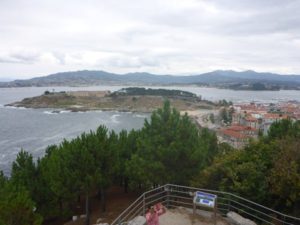
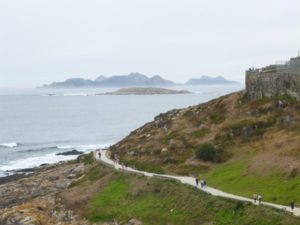
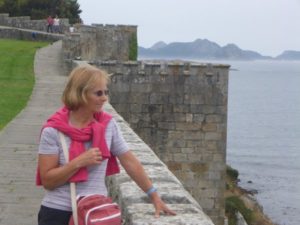
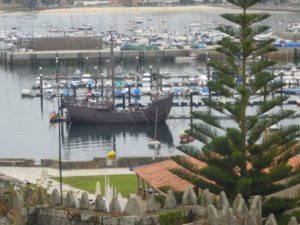
Our perambulations continued with a climb up to the beautiful statue of the Virgen de la Roca. She has a lovely face and her elegant robes are effectively floodlit a night, we stayed up that night just to see them being turned on.
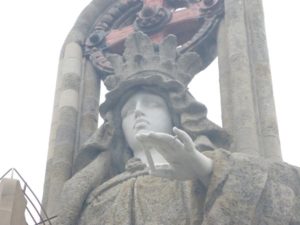
16th August. We motored across the bay to look at Panjou with its quirky little 20th century church, with the intention of staying the night but we were anchored in line with the Atlantic swell and though we discussed the likes of a little of the mainsail released to stabilise us, or a kedge anchor let out astern so we could hold her at right angles to the swell we eventually decided to head back to the anchorage just outside the marina.
Here we spied a very fine Oyster called Enjoyster and owned by Peter and Myriam from Holland. We were surprised to hear she is two years older than Zoonie, but then they have done a pretty thorough refit on her. She is 53 feet long and enjoys the luxury of an extra bunk cabin and a utility room with washing machine. No, I’m not jealous. Myriam also has here sewing machine on board, now maybe I am a little jealous. Despite making things for Zoonie like a Mobmat Bag (man overboard gear), new curtains and a bag for our inflatable dinghy before we left home I decided to leave my machine behind as it was made in 1894 and I was afraid it would go rusty.
Next morning, when I was happily boiling a kettle for early morning tea, there was a knock on the hull by the galley. I poked my head out and there is Peter in his dinghy clutching a bag containing a still warm loaf of bread, what a gem that man is.
The day was very foggy, but we wanted to move on. Bayona ‘revisited and done’ we prepared to leave, fog horn at the ready, about an hour after Enjoyster, bound for Viana do Castello about 30 miles down the coast, out of the beautiful Rias finally and back into the Atlantic.
Embarking down the Portuguese Coast
41:40.34N 008:50.43W
Viana do Castelo and Hello Portugal.
“I show you where to go, please come in backwards” Renarto’s voice carried well from his work boat as he came out to greet us, peaked cap reversed on his head and sporting a black beard. He tied up his work boat and was ready on the pontoon showing us with his hands exactly where he wanted Zoonie’s transom to be parked. Poor Rob. Zoonie is not the easiest hull to reverse in a straight line and here we had little room. As Rob gently coaxed her backwards I threw a mooring line to Renarto and he passed me the line that runs out from the pontoon at a right angle and is designed to be tied to a forward cleat on Zoonie’s foredeck and keep her bow in position.
A few minutes later Enjoyster arrived. She had had a slow start but then sailed at over 10 knots with full rig. As we had less time to cover the distance in light airs we had cheated with the motor. We were invited aboard for drinks in the cockpit in time to see the replica HMS Pickle, all 19 metres of her, arrive and squeeze in between Enjoyster and the harbour wall. Two workboats acted as tugs and pushed and pulled until she was in place.
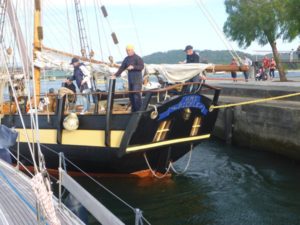
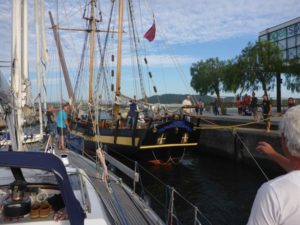
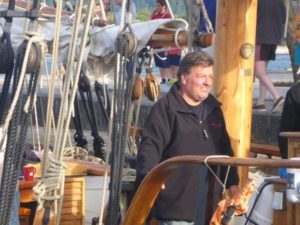
The original HMS Pickle was one of the fastest vessels at the Battle of Trafalgar in 1805 and was given the dubious task of returning to London as quickly as possible to report Nelson’s victory and his death. The captain spent half his year’s salary hiring coach and frequently changed horses to carry the news from Falmouth to the capital.
This replica Pickle was on her way to the Humber via a spell in Portmouth with the Victory after an extensive refit. Built mostly of larch to keep her light she was almost a wreck when the current owner purchased her, having been used as a party and events boat and no maintenance being done for years.
When we were approaching Viana in a 30 knot wind Pickle was a few miles further out where she was experiencing 49 knots of wind. Fortunately she can call on her 125hp motor to help matters. She has a global following and ancestors of the original captain keep in touch with her progress.
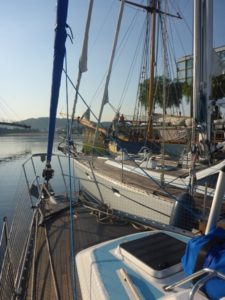
18th August. First job ashore was to find a hairdresser. Rob had made a good job of shortening my hair but struggled with the layering so we decided I needed to be ‘tidied up’. That was how Cristina Castro tactfully put it at C3 Cabeleireiros. She sent us off to have a coffee until 9.30 when she would start work. She worked magic making me look as if I had more hair after she razored the back than before she started. She only had to show the hair the razor and it fell off.
Next we walked into the old town which was a hive of activity, scaffolding and workmen all over erecting mass tiered seating areas up the sides of all the main streets. There was an atmosphere of contained excitement. Men holding fistfulls of strings of brightly coloured balloons and heads of giants (gigantones), that looked as if they were made of papier mache, were displayed at shop doors and in windows. The most important festival of the year would start the next day in honour of Nossa Senhora da Agonia, patron saint of fishermen. Cristina said it was a must for us with more than 1 million visitors. A vast flotilla of boats leaves the harbour with the effigy of the patron saint on one of them, and bunches of flowers are thrown onto the ocean turning it into a garden in spring time. We were put off by the size of the crowds and decided to leave the following day. I know, we’re a couple of boring old folk aren’t we.
But not before taking the funicular (on Sue of Larry’s recommendation) up to the Basilica on Monto de Santa Luzia for a panoramic view over the estuary and city. Again some distinguished lady reported it as the finest view in the world. She definitely needed to travel further to broaden her perspective.
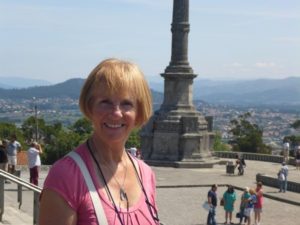
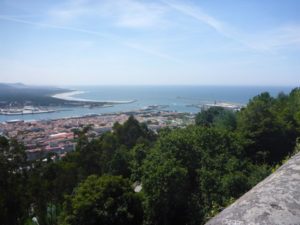
41:11.08N 08:42.24W
Leixoes and Porto
After a 7.40am start we had a perfect sail, goose-winged down to Leixoes Harbour and anchored in the corner between the marina harbour mole and the breakwater. The lady in the marina kindly gave us permission to leave the tender alongside a pontoon. We took the 500 bus along the sea and riversides into Porto. We could have taken the air conditioned metro for the same price and in half the time but wanted the views, over the heads of the people in a baking hot, full bus.
Despite it being late in the evening the tourist info office was still open and we booked an all-day river trip for the Friday, the day after next. Back to the boat via the metro, cool bliss.
That evening I experimented with cooking two cross sections of conger eel I had bought in a supermarket. I rose above the damp pants smell of the raw eel and cooked it for a generous time, but even then it was nearly impossible to get it off the bone. It tasted ok. If there is a next time I will buy fillets.
20th August. Poor Rob awoke with a poorly tummy, now I know what you’re thinking but as I had eaten eel as well I don’t think it was that. On the way in to Porto we had to leave the metro for a few minutes while he was sick behind a friendly tree. The strain must have upset his old back complaint which then swelled up and trapped a nerve in his leg, so by the time we reached Porto he was in agony. We found a pharmacy and bought some Ibuprofen, but as the pharmacist said he must only take it after a meal we hired a taxi back to the marina where I gave Rob a quick lunch and in minutes he was fast asleep with the Ibu doing its good work.
As I sat reading in the cockpit I wondered why so few yachts appear to use the anchorage, instead belting across the harbour into the marina as if there’s a gale up their tail. We had three quiet, calm nights there and there were always interesting ship movements going on for entertainment. Enjoyster came out of the marina that evening and joined us and as Rob awoke feeling like a new man we invited them across for drinks. They anchored a little behind us so I couldn’t see into their cockpit to gain their attention. Well I tried calling them on the radio and then across the water. Finally I knew what would get their attention, “Parp” on the canister foghorn; that worked. At last we were able to return their hospitality.
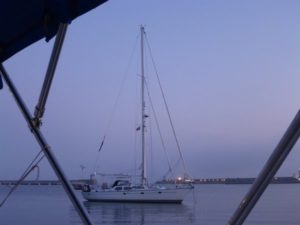

21st August. Porto Day. We walked into the metro station at 7.37 in the fog. Strolled down to the magnificently decorated St Bento station at 8.10 and made contact with our guide, Daniel, who had the cushiest job ever, guiding folk through the vineyards of Portugal. Clasping two mugs of delicious coffee to go we wandered around admiring the blue ceramic tile narrative celebrations of Portuguese life and history. At 9.10 our train started on its 2 hour upriver journey to Regua to meet our river boat of the Tomaz do Douro line.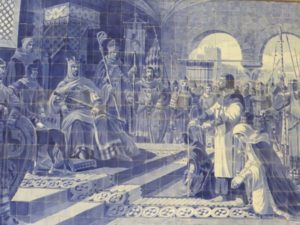
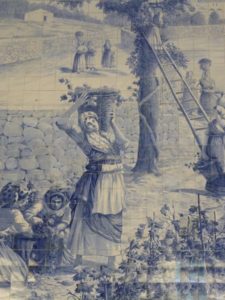
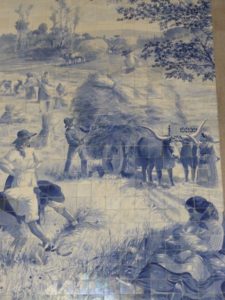
Travelling along at 10 knots created a glorious breeze on what was turning out to be a fine, hot day.
After a few minutes lunch was served in the cool interior dining room, surrounded by lots of well-rounded panels of varnished wood. Vegetable soup, rice, potato and cooked cabbage with roast pork and chocolate cake for dessert, washed down with local red wine and white port.
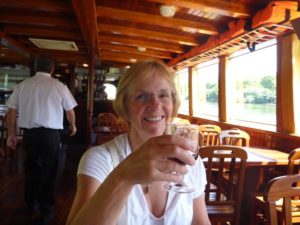
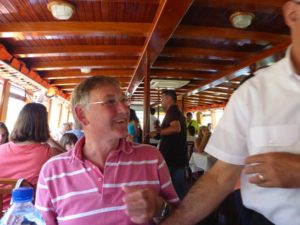
Our ship sped on past terraced vineyards, mixed woodland, rocky shores and delightful little beaches where people relaxed and played.
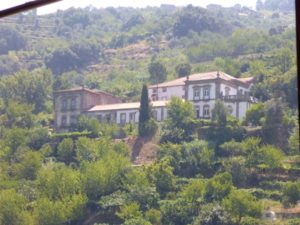
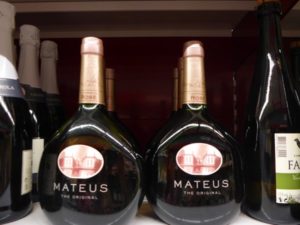
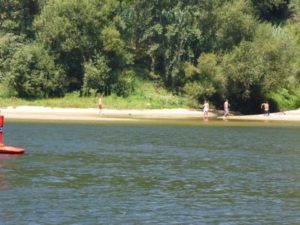
Two lock systems provided excellent entertainment. The first drops 33 metres, (the Panama lock into the Pacific from the Caribbean drops 80 metres) and the curved gate infront of us lifts up to let vessels through. Just before it breaks the surface you can see lime green sunlight through the water under the gate, quite beautiful.
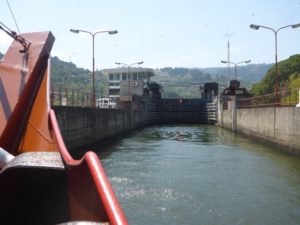
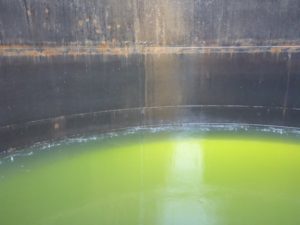
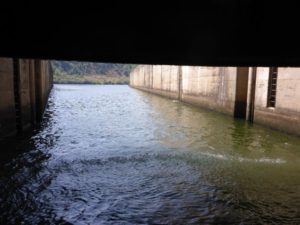
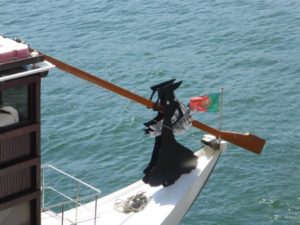

We strolled up the steep hill through old Porto to Trindade metro station for our journey home and spent the evening chatting to family about our fine day.
